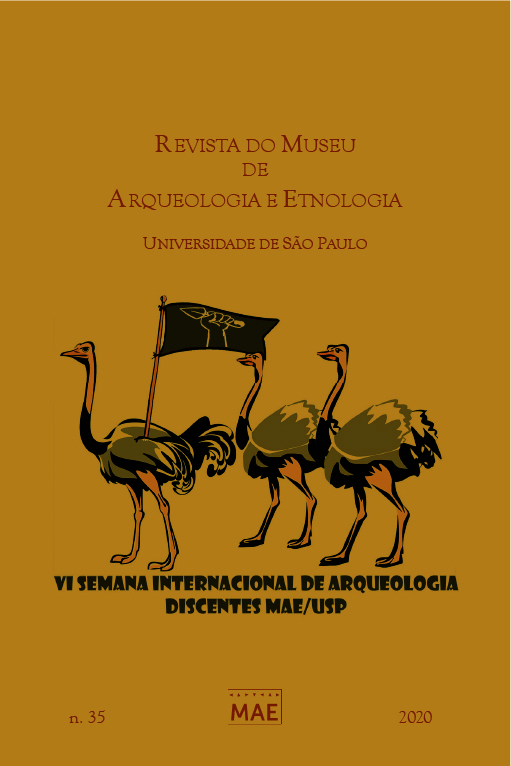The role of amulets in cemeteries of the non-elite in Ancient Egypt
DOI:
https://doi.org/10.11606/issn.2448-1750.revmae.2020.163425Keywords:
Amulets, Ancient Egypt, Non-elite, Funerary practicesAbstract
This article aims to expand the notion of amulets in Ancient Egypt through the discussion of aspects of the contextualization of these objects in non-elite cemeteries. Therefore, we will demonstrate contextual variability and a social diversity characterized by different practices, appropriations and re-significations of this material culture in burials. The intention is to question general interpretations of amulets constructed from textual and iconographic sources available only to the elite. Through contextual analysis of data of amulets found in cemeteries from three sites, Gurob, Matmar and Lahun, we aim to reflect on the different practices and beliefs regarding the non-elite.
Downloads
References
Andrews, C. 1994. Amulets of Ancient Egypt. British Museum Press, London.
Aston, D. 2009. Burial assemblages of dynasty 21-25: chronology, typology, developments. Verlag der Österreichischen Akademie der Wissenschaften, Vienna, Austria.
Baines, J.; Lacovara, P. 2002. Burial and the dead in ancient Egyptian society: Respect, formalism, neglect. Journal of Social Archaeology 2: 5-36.
Barguet, P. 1967. Le Livre des Morts des Anciens Egyptiens. Les Éditions du Cerf, Paris.
Brunton, G. 1920. Lahun I: The Treasure. Bernard Quaritch, London.
Brunton, G. 1948. Matmar. Bernard Quaritch, London.
Brunton, G.; Engelbach, R. 1927. Gurob. BSAE/ERA 10, London.
Bussmann, R. 2015. Egyptian Archaeology and Social Anthropology. Oxford Handbooks Online. Disponível em: <https://bit.ly/32w1ZST>. Acesso em: 27/08/2020. DOI 10.1093/oxfordhb/9780199935413.013.24.
Cahail, K.M. 2014. In the Shadow of Osiris: Non-royal mortuary landscapes at South Abydos during the late Middle and New Kingdoms. PhD Thesis. University of Pennsylvania, Pennsylvania.
Grajetzki, W. 2010. Class and Society: Position and Possessions. In: Wendrich, W. (Ed.). Egyptian Archaeology. Blackwell Publishing, Oxford, 180-199.
Goulding, E. 2013. What did the poor take with them? An investigation into ancient egyptian eighteenth and nineteenth dynasty grave assemblages of the non-elite from Qau, Badari, Matmar and Gurob. Golden House Publications, London.
Hodder, I. 1987. The Contextual Analysis of Symbolic Meanings. In: Hodder, I. (Ed.). The Archaeology of Contextual Meanings. Cambridge University Press, Cambridge, 1-10.
Hodder, I. 1992. Theory and Practice in Archaeology. Routledge, London.
Hodder, I.; Hutson, S. 1986. Reading the Past. Cambridge University Press, Cambridge.
Humphreys, R. 2010. Matmar: Revisiting Burial Practice of the Non-Elite during the Third Intermediate Period. PhD Dissertation. University of Birmingham, Birmingham.
Ikram, S. 2003. Death and burial in ancient Egypt. The American University in Cairo Press, Cairo.
Janulíková, B. 2017. Non-elite mortuary variability in the Early Dynastic Memphite region. Tese de doutorado. University of Cambridge, Cambridge.
Kemp, B. 1984. In the Shadow of Texts: Archaeology in Egypt. Archaeological Review from Cambridge 3: 19-28. Disponível em: <https://bit.ly/2QuFrwn>. Acesso em: 27/08//2020.
Kemp, B. et al. 2013. Life, death and beyond in Akhenaten's Egypt: excavating the South Tombs Cemetery at Amarna. Antiquity 87: 64-78.
Lemos, R. 2015. Os costumes funerários da não elite no Egito e na Núbia durante o Reino Novo: os cemitérios de Fadrus, Tell el-Amarna e Medinet el-Ghurab (XVIII-XIX dinastias). Dissertação de mestrado. Museu Nacional, Universidade Federal do Rio de Janeiro, Rio de Janeiro.
Lemos, R. 2017. Material culture and social interactions in New Kingdom non-elite cemeteries. In: Chyla, J. et al. (Eds.). Current Research in Egyptology 2016: Proceedings of the Seventeenth Annual Symposium. Oxbow, Oxford, 121-135.
Lemos, R. 2018. Materiality and cultural reproduction in non-elite cemeteries. In: Maynart, É. et al. (Eds.). Perspectives on materiality in ancient Egypt — agency, cultural reproduction and change. Archaeopress, Oxford, 24-34.
Muñoz Pérez, C. 2018. “All that glitters is not gold”: the symbolism and materiality of Egyptian funerary amulets. In: Maynart, É. et al. (Eds.). Perspectives on materiality in ancient Egypt — agency, cultural reproduction and change. Archaeopress, Oxford, 64-73.
Petrie, W.M.F.; Brunton, G.; Murray, M.A. 1923. Lahun II. British School of Archaeology in Egypt; Bernard Quaritch, London.
Pinch, G. 1993. Votive offerings to Hathor. Griffith Institute, Ashmolean Museum, Oxford.
Pinch, G. 2000. Redefining Funerary Objects. In: Hawass, Z. (Ed.). Egyptology at the Dawn of the Twenty-First Century, Volume II. The American University in Cairo Press, Cairo, 443-447.
Pinch, G. 2002. Handbook of Egyptian Mythology. ABC-Clio, Santa Barbara.
Richards, J. 2005. Society and Death in Ancient Egypt: Mortuary Landscapes of the Middle Kingdom. Cambridge University Press, Cambridge.
Shaw, I. 2000. The Oxford History of Ancient Egypt. Oxford University Press, Oxford.
Stevens, A. 2006. Private religion at Amarna the material evidence. Archaeopress, Oxford.
Taylor, J. H.; Antoine, D.; Vandenbeusch, M. 2014. Ancient lives, new discoveries: eight mummies, eight stories. The British Museum Press, London.
Downloads
Published
Issue
Section
License
Copyright (c) 2020 Victoria Arroyo

This work is licensed under a Creative Commons Attribution-NonCommercial-NoDerivatives 4.0 International License.
Funding data
-
Fundação de Amparo à Pesquisa do Estado de São Paulo
Grant numbers 18/15426-7













